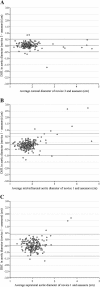Novices may be trained to screen for abdominal aortic aneurysms using ultrasound
- PMID: 24261878
- PMCID: PMC3874661
- DOI: 10.1186/1476-7120-11-42
Novices may be trained to screen for abdominal aortic aneurysms using ultrasound
Abstract
Background: Highly trained vascular sonographers make up a significant cost of abdominal aortic aneurysm (AAA) ultrasound screening. However, they are over-trained for this very limited task. Others have reported that health workers (e.g. emergency room staff and nurses) with far less training may be able to perform these scans. The national AAA screening programme in the UK uses staff with limited training. Whether individuals without a health professional qualification could be trained to perform the scan accurately to improve cost-effectiveness is not known. We aimed to investigate whether a short, well-supervised course in ultrasonography could train novices to detect AAA for screening purposes.
Methods: Three novices were trained by an experienced sonographer for 15 days to perform abdominal aortic ultrasound examinations and detect AAA using a portable ultrasound system. The examination included four anterior-posterior aortic measurements: a maximal diameter in the coronal plane and three diameters of the suprarenal, mid and distal infrarenal aorta in the transverse plane. The novices independently scanned 215 subjects following training; experienced sonographers repeated the measurements on the same subject in the same session. Using Bland-Altman plots and CUSUM analysis, the novices' and experienced sonographers' accuracy and efficiency measurements were compared. Factors influencing performance were recorded.
Results: The novices measured the maximal coronal aortic diameter accurately, to within 0.46-0.52 cm of the true diameter; 85-97% of their coronal measurements were within 0.5 cm of the assessors; kappa statistic and Bland-Altman plots show a high agreement with the assessor's measurements. However, the novices' measurements of the three diameters in the transverse plane were outside clinically acceptable limits. Assuming a referral policy for a second scan for scans recorded as 'difficult', only one novice missed a 3.13 cm aneurysm.A CUSUM quality improvement analysis demonstrated substantial improvements in the scanning efficiency of the novices with continued scanning experience.
Conclusion: This study showed that novices could be trained to screen for AAA over 15 days. However, the need for continuing quality improvement is critical, especially in more technically demanding cases. Measuring the maximal infrarenal diameter instead of specific segmental diameters may be more appropriate for AAA screening using novices.
Figures


References
-
- Cosford PA, Leng GC. Screening for abdominal aortic aneurysm. Cochrane Database of Syst Rev. 2007;2 CD002945. - PubMed
-
- Collaborative Aneurysm Screening Study Group (CASS Group), Chichester Aneurysm Screening Group (UK), Viborg Aneurysm Screening Study (Denmark), Western Australia Abdominal Aortic Aneurysm Program (Australia), and Multicentre Aneurysm Screening Study (MASS)(UK) A comparative study of the prevalence of abdominal aortic aneurysms in the United Kingdom, Denmark, and Australia. J Med Screen. 2001;8:46–50. - PubMed
-
- Sandiford P, Mosquera D, Bramley D. Trends in incidence and mortality from abdominal aortic aneurysm in New Zealand. Br J Surg. 2011;98:645–651. - PubMed
Publication types
MeSH terms
LinkOut - more resources
Full Text Sources
Other Literature Sources

